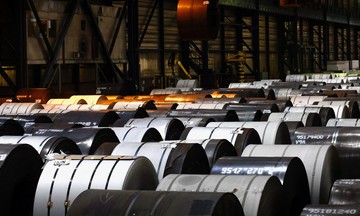With support from the Serbian government, the United Nations Development Programme (UNDP), and European Union (EU) funders, the Institute of Biology Belgrade is conducting a project training mealworms (Tenebrio molitor), the larvae of the darkling beetle, to consume polystyrene (PS) plastic. This type of plastic, also known as number 6 plastic, is commonly used in packaging, disposable food containers, and insulation.
Lead researcher Larisa Ilijin explained that PS has been added to the mealworms' typical diet of wheat bran and flour. Mealworms are omnivorous, making them adaptable to consuming various materials, including plastic.
"We now have worms adapted to a long-term plastic decomposition process," Ilijin said. She added that bacteria in the mealworms' guts break down the plastic into carbon dioxide (CO2) and water. There's no evidence of microplastics remaining in their guts or excrement.
Serbian scientists train worms to eat plastic. Source: Reuters
The use of worms for plastic disposal, a bio-remediation solution, was first discovered by European scientists in 2017. This discovery, involving waxworms (the larvae of the wax moth) consuming polyethylene (PE) plastic, offered a new approach to plastic waste management. PE plastic's structure is similar to beeswax, the waxworms' primary food source. This finding sparked further research into using insects for plastic decomposition.
Selected worms were deprived of food and then offered different types of plastic. PS and PE, two common types of plastic, became the focus of these feeding experiments.
Two months ago in Canada, biology professor Bryan Cassone at Brandon University announced a successful trial where 2,000 waxworms consumed an entire nylon bag (made of PE plastic) within 24 hours. However, a diet solely of plastic resulted in significant weight loss and death for the waxworms within days, indicating challenges for continuous PE processing. Researchers believe that supplementing their diet could improve their survival rates and decomposition efficiency.
Scientists view worms as an ideal component of a circular economy. Depending on the byproducts, the worms themselves could be used as animal feed. The Institute of Biology Belgrade donated some of its research worms to Belinda Animals, a Belgrade-based company specializing in large-scale worm farming for plastic processing. These worms are rich in protein, free from pollutants and plastic residue, and have the potential to become a sustainable animal feed source at a commercial scale.
"When decomposing 1 kg of polystyrene foam, the mealworms release 1-2 g of CO2. In comparison, incinerating the same amount of foam would release 4,000 times more CO2," said Boris Vasiljev, owner of Belinda Animals.
In a presentation to the UNDP, Belinda Animals representatives stated that this model could revolutionize waste management and promote sustainable agriculture. If implemented in just 1% of Serbian farms, this initiative could potentially reduce greenhouse gas emissions by 348,430 tons of CO2e over 20 years.
Bao Bao (according to Reuters, Wired)












